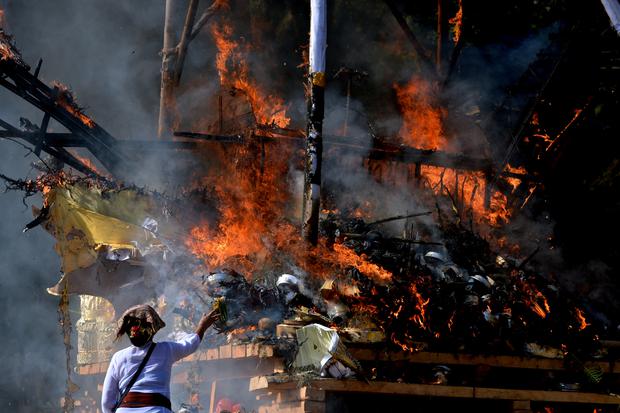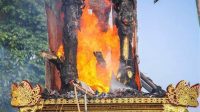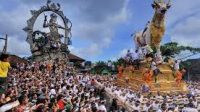KUPASONLINE.COM — The Ngaben tradition is a traditional ceremony of burning the bodies of Hindus, especially in Bali. The Ngaben ceremony is also known as Pitra Yadyna, Pelebon, or cremation ceremony.
The Ngaben tradition aims to release the souls of people who have died so they can enter the upper realm where they can wait to be reborn or reincarnated.
The Balinese indigenous people believe that the cremation tradition can also purify the spirits of family members who have passed away to their final resting place.
The Ngaben tradition is a sacred and lively ceremony, not only for the people of Bali, but also for tourists. According to the Tempo Analysis Team in the book “Knowing Ngaben Deeper: The Tradition of Burning Bodies in Bali”, Ngaben comes from the word ‘beya’ which means provisions. There are also those who say Ngaben comes from the word ‘ngabu’, which means to turn to ashes.
The Concept and Process of the Ngaben Tradition
According to the beliefs of Hindus in Bali, humans consist of a gross body, a subtle body, and karma. The gross human body is formed from 5 elements called the Panca Maha Bhuta, namely earth (solid), apah (liquid), teja (hot substance), bayu (wind), and akasa (vacuum).
These five elements unite to form the human body and are driven by the atma (spirit). When a human dies, it is only the gross body that dies, but not the atma.
For the Balinese people, Ngaben is a very important event, because by carrying on this tradition, families can free the spirits of people who have died from earthly bonds to go to heaven and wait for reincarnation.
By burning the corpse or symbolically then washing the ashes into the river or sea has the meaning of releasing the Atma (spirit) from worldly shackles so that it can easily unite with God (Mokshatam Atmanam).
Burning the corpse is also a series of Ngaben traditions to return all the elements of the Panca Maha Bhuta (the 5 elements that make up the gross human body) to their respective origins so as not to hinder Atma’s journey to Sunia Loka.
For the family, this Ngaben tradition is a symbol that the family has been sincere and has given up the person concerned. If Ngaben is delayed too long, the spirit will wander and become bhuta cuwil. Likewise if someone who dies is buried in the ground without proper ceremony.
This is because the spirits have not let go of their attachment to the human realm. So, it is necessary to hold the Ngaben Bhuta Cuwil ceremony.
The Ngaben tradition includes expensive ceremonies. Those who have enough funds should immediately implement it. If a priest dies, then Ngaben must be carried out immediately, and may not touch the ground.
The process of the Ngaben ceremony is quite long. Starting with Ngulapin, the family performs a ritual of asking for permission and blessing to the Goddess of Heaven who is the magic of Lord Shiva.
Ngulapin is done at Pura Dalem. After that, the Mesheh Lawang ceremony is carried out which aims to restore the defects or damage to the corpse which is done symbolically.
The Meseh Lawang ceremony is carried out at the catus pata or on the edge of the grave. Next is the Egyptam or Mabersih ceremony, which is washing the bodies, which are sometimes only bones, performed at the funeral home or cemetery. The first stage is the Ngaskara ceremony, which is the initial stage of the soul purification ceremony.
Followed by Nerpana, which is the ceremony of offering offerings or offerings to the souls of those who have died. The culmination of the Ngaben procession is Ngeseng Sawa, which is the burning of the corpses which is carried out in setra or graves. The body to be burned is placed in a replica of an ox called Petulangan.
Petulangan is a place where the corpse is burned which functions as an introduction for the spirit to the realm of the spirit according to the results of its deeds in the world. After the body is burned, the Nuduk Galih ceremony is performed, in which the family collects the remains of the bones (ashes) of the corpse after being burned.
The last procession is Nganyut, which is washing the ashes of the corpse into the sea, as a symbol of the return of the water element and the reunion of the soul with nature.
In the Ngaben tradition, all residents of the banjar (at the same level as the pillars of the community) must assist in the preparations. Many offerings were prepared and various purposes for the procession were made. Two important things to make are badé and patulangan.
Badé are pagoda-like towers with an odd number of places to carry dead bodies. Patulangan is a sarcophagus in the shape of a mythological animal or creature where the body will be cremated. Badé and patulangan have various sizes and shapes which indicate the social status of the deceased.
Since the 2000s, the wheeled badé phenomenon has emerged. Namely the badé which is fitted with wheels so that it can be pushed. The wheeled badé allows the cremation procession to be simpler without the need for a lot of effort and other equipment which costs a lot.
Types of Ngaben Tradition
The Ngaben tradition in Bali is not only carried out by burning the corpses. There is also a burial ceremony known as Ngaben Beya Tanem.
This tradition has been passed down from generation to generation by the Balinese who live in mountainous areas. This ceremony cannot be separated from the elements of ceremonies from prehistoric times to the ancient Bali period before the influence of Hinduism from Majapahit entered.
In carrying out the Ngaben tradition, there are various types of procedures that are carried out, depending on the ability of the deceased’s family. The procedures for carrying out the Ngaben Tradition also conform to customary policies from generation to generation. There are several types of Ngaben Tradition ceremonies as follows:
1. Ngaben Sawa Wedana tradition
The Ngaben Sawa Wedana tradition is carried out when the body is still intact, or not buried beforehand. This Ngaben tradition is carried out between 3-7 days after death.
2. Ngaben Asti Wedana Tradition
Asti Wedana is a Ngaben ceremony which involves skeletons that have been buried. This ceremony is also followed by the Ngagah ceremony, which is the ceremony of exhuming the grave of the person concerned and then ceremonizing the remaining bones. This procession is carried out according to local village traditions and rules.
3. Private Ngaben Tradition
Private is the Ngaben ceremony without showing the bodies or skeletons. This is usually done for several reasons, such as dying abroad or far away, bodies not being found, and so on.
In this ceremony, the body is usually symbolized by painted sandalwood and filled with magical characters as the rough body of the person’s atma.
4. Ngaben Ngelungah Tradition and Warak Kruron
Ngelungah is a ceremony for children who have not lost their teeth. While Warak Kruron is a ceremony performed for babies. Usually, this ceremony is carried out en masse to reduce costs without reducing the meaning of the ceremony.
(*)







